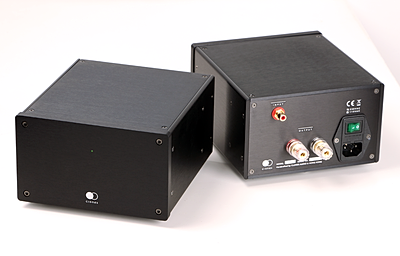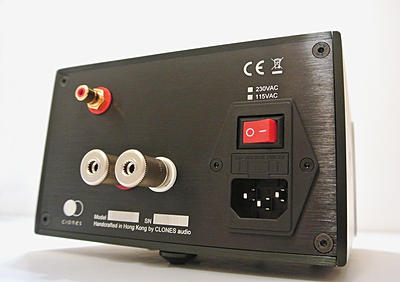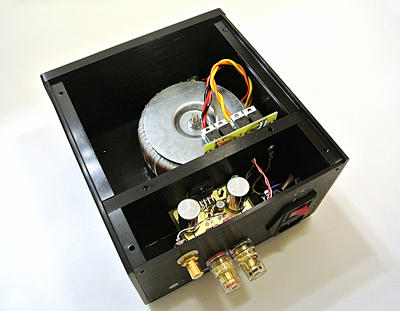- UK importer is LW Audio (Mr. Iain Borthwick) http://lwaudio.co.uk/clones-audio
- iainborthwick@me.com
- UK RRP £1,129 including VAT @ 20% per pair
- This is part #2 of a two-part test review and is an investigation of the 55PM mono power amps
---//--
Preliminary notes:
Overlap; the opening parts of this review are identical to those I wrote re the matching AP2 remote control preamp. With this in mind, if you’ve already read that review then you might want to scroll down in this one to ‘Ah ha – a design philosophy not dissimilar to LFD Audio. Cloned perhaps?’
Thank you
Neil McCauley / editor in chief
Clones who?
A good question. A new brand in the UK, this Hong Kong based organisation was founded on 12/12/12. This is what they say on their minimalist website:
‘Our goal is creating affordable components bringing you closer to the soul of music.
Our goal is producing ELEGANT, AFFORDABLE audio gear, carrying you into the HEART of MUSIC.
“But thou shalt remember the Lord thy God: for it is he that giveth thee power to get wealth, that he may establish his covenant which he sware unto thy fathers, as it is this day.” - Deuteronomy 8:18
The capitals and italics-are theirs, not mine!
Specifications
- 55w in 8 ohms and 100w into 4 ohms
- Gain 30dB
- Input impedance 22k
- Signal To Noise Ratio <95db (min)
- 170w x 100h x 170d
- 4.2kg each
They say:
“55pm is the new power amplifier to replace the 50pm. Separate casing and power supply provides cleaner imaging and more extension on both ends of the audio spectrum as your speakers have the power they need to reproduce demanding frequencies and dynamic range. The 55pm has more punch and control over the lower frequency while 25pm sounds a bit warm in comparison.”
Cynical? Who, me?
Well okay, fair enough – it’s easy to be cynical. Doesn’t every maker state something like this? Moreover the initial impression from the weighty but as yet unpacked cartons was not entirely encouraging. Plain cardboard. Hardly an Apple product in this respect. The instruction manual is rudimentary, to put it mildly. Hardly an auspicious start. Meanwhile …
But then it gets better; very much better in fact.
Immediately I was struck by the superb build quality from the black anodized bolt-together cases and the first-class rear panel connections. Beyond superb in fact because – within the price band –this quality of construction is outstanding, possibly exceptional. Encouraging!
Please take note of the implications behind the phrase ‘within its price band’. Without this, all manner of absurdities spring to mind such as …….. are they really implying that these can hold their own against say an Accuphase monster Class A, the best Krell can offer and so on? Of course not.
Before I get into the meat of the product I'll offer part of my conclusion and summary now. In my direct personal experience I’m not only convinced that the 55PM mono amps really do ‘offer a significant step forward in capturing the subtleties, nuances and emotions of music’ within its circa £1k price band but at least into the £2k band and close to a £3k band.
Is these genuine giant killers?
I'm assuming here that my sample is representative of the quality an end-user would buy off the shelf rather than ‘blue printed’ i.e. a non representative example purposefully built for a review situation. If so and I have no reason to doubt otherwise then I have to say that these are cast-iron, copper-bottemed giant killers. If you’ll let me continue then I'll give my reasons for the above.
The look and the feel
In a word …’ sturdy’. These look and feel classy; expensive but austere. There’s not a milligram of bling here. I like this. I find it elegant but others might not. Everything feels substantial ….. right down to the tri-point feet. The input and output terminals feel state-of-the-art and have a reassuring snugness when plugs are inserted and removed.
Operation is very simple and straightforward which is just as well as laughingly misnamed ‘user manual’ comprises a couple of cheaply produced laser-printed sheets of cheap paper. Feeble is putting it mildly.
I suppose, like the uninspiring packaging the makers have decided that the majority of the investment is in the product itself and that everything else is peripheral to the point of being irrelevant. I can understand that point of view but … personally I find it uninspiring. Anyway, that’s my issue rather than yours and I mention it only for your information.
Ah ha – a design philosophy not dissimilar to LFD Audio. Cloned perhaps?
I'm putting the cart before the horse here, a bit. Later you’ll read how I used these power amps with various pre amps (mainly the matching AP2) and ended up comparing these to others, the LFD Audio PA2M (SE) (courtesy of Howard Popeck) and various Musical Fidelity and Quad power amps courtesy of a friend.
The odd thing is that sonically these 55pm power amps sound virtually indistinguishable from the PA2M (SE) other than … well, I'll come to that later here.
A bit surprising and so I did a bit of investigating. I got an insight into the brand name Clones. I thought it an odd name and put it down to either eccentricity or perhaps a misunderstanding due to the difference between Hong Kong’s understanding of the word compared to ours. I was wrong on both instances.
It turns out that indeed Clones’ design philosophy is to be “inspired” by successful and innovative circuit designs that deliver on the promise but possibly have emerged from state-of-the-art cottage industries. LFD Audio fits into this category.
I'm certainly not implying a direct copy of the LFD Audio design. That said, both brands share a similar ethos. Minimalist, uncomplicated and thoroughly well engineered circuitry that probably hasn’t evolved through decades but, and this is the crucial aspect, loaded with the finest components that can be purchased within the financial build-plan.
How does it sound?
On and off, I used the 55PMs for nine weeks, on and off and mainly with the matching AP2 pre amp. Using CD the AP2/55PMs sound was characterized by its clean, very detailed presentation. The low frequencies were tight and well-defined, but lacked the lower-midrange bloom of the much more expensive LFD and the Quad Elite Stereo. Though this gave the LFD the advantage when it came to reproducing classical orchestral music, the 55PSs especially when driven by the AP2 edged out ahead – a bit – on rock music, where their cleaner low-frequency presentation and a perception of a greater bass extension enabled it to score big time.
In short, I think the guys at Clones have created a very musical pair of power amps and one I would highly recommend on my experience to date. They will happily compete at the lower reaches of the high end albeit for some applications I found them a little under powered.
Let's consider aesthetics and build quality first. They clearly lack the bling factor of most mono amps. I like that. No quarter-inch thick front plates here; no flashing lights either. In a previous draft of this overdue review I wrote that “they’ll win no beauty contests” and I went on to write that “the appearance is passable.” But ….. they’ve grown on me. So after some weeks, well ….. I really, really admire the starkness; the anonymity.
I didn’t peek inside. I leave that sort of thing to the techies. That said ….. and such is the (for me) unavoidable impact of design cosmetics that appeal to me I’m confident that most of the engineering cost has gone inside the amp rather than out. If you want bling then buy jewellery. I want music.
These amps require extensive running in. For the first 100 hours of use I felt they sounded grainy and reedy with limited bass definition. Coming back from a trip away (having left them powered up for a week) I immediately noticed the sound to be crystal clear with very well defined highs, lows and mids. From that point on I was treated to the sonic delights that these amps are capable of. Whether you like rock, country, folk or classical, you'll hear whatever is on the disc faithfully and in superb (in its price band) detail.
On Christine Collister Live (2001) the remarkable fretless bass work was immediately defined in space while the timbre was totally believable. ‘Last Chance Texaco’ and ‘Ruby’ sent shivers down my spine. ‘I Keep Forgetting’ and ‘Human Nature’ were in terms of exuberance not far behind my reference LFD Audio PA2M (SE). The sparse production was ruthlessly and agreeably revealed – just acoustic guitars and bass.
Brahms The Symphonies Gewandhaus Orchestra / Riccardo Chailly – The first thing to say is that this recording sounds tremendous, thanks both to wonderfully lucid engineering that allows you to hear almost everything and to the sound of the Leipzig Gewandhaus Orchestra. Those who heard the orchestra at the 2014 Proms will not be surprised to be told this. The principal oboe plays ravishingly, if with rather a lot of notes not fully centred in pitch. Through the AP2/55PMs it was a wonderfully engaging experience.
REM Live. Opinions vary about the relevance and value of live recordings. I'm afraid I love them and am always excited when they are released but then I’m a little old fashioned (I also thought that ‘Around The Sun’ was an interesting and likeable album; so there you go). That said, I'm usually disappointed as rock artists usually swear or talk drivel to the audience which, for me, I'd rather not listen to. Consequently I'm always looking for the "perfect" live album where songs are sung and banter withheld.
Through the 55PMs it’s clear that this album is not the greatest live album ever made - the sound mix is not 100% to my liking BUT I do get that buzz and tingle from it ; they sing the songs and the comments are minimal. Via the Clones Audio I think this cd will continue to grow on me and whereas previous on some systems I wasn’t convinced, I’m now a satisfied REM fan.
Buddy Guy Rhythm & Blues (Disc 2). Now here’s an odd thing and with no explanation that I can offer, although familiar with these two discs, via the 55PMs I found myself mentally writing a review of the music rather than the equipment. Here’s what I wrote, in rough form. Given the unusual diversion here in this review, I'll leave my comments re the music to illustrate just how revealing these fine power amps are.
Rhythm and Blues" has the odd weakness but that’s because it is about the generosity of this great guitarist and his desire to play with musical all comers. With 21 tracks spread over 80 minutes there are weaker moments and they are largely confined to the guest material. The version of Junior Wells "Messin with the Kid" suffers from the very strained vocals of Keith Rock who is no blues natural and perhaps the "welcome mat" should have been left inside the door. In any case Rory Gallagher's version remains unbeatable. This album is very polished and subject to a big production but in execution some of the raucous charm to be found on his live performances are absent.
Now then, moving on: Wendy Carlos – Switched On Bach. Oh wow, I wasn’t expecting the level of bass response I usually get from more muscular amps. Moreover earlier on in this review I implied a lack of bass ‘heft’. On some recordings with other artists I did experience this …. but not here and not now. The lovely, organic, fuzzy, rich sounds those old synths made really suit the Bach works on this CD. This is extraordinary not just for the music, but for the amount of work that must have gone into producing it back in '68, without digital sequencers and all the easy-peasy stuff lying around in electronics shops these days. this was hand-made. A thoroughly enjoyable experience.
In draft #1 of this review I wrote: ‘I could go on ….. but I'd rather stop and start listening to the AP2/55PMs again. These amps are nothing short of superb and a huge achievement Clones Audio in my view. It was no accident that the TV remained off and the Clones Audio boxes on for at least 3 hours a night during the listening period.
Between draft #1 and this, the final draft, this marginalisation of my TV continued.
What other equipment did I use?
- PS Audio P3 Power Plant (mains regeneration) and PerfectWave Power Base.
- Harbeth SHL5 speakers on anonymous cheap but rigid wooden stands and occasionally Burton Somervell hybrid ribbon / cone floorstanders. Also JPW Minims
- Stereovox and LAT speaker cables
- LAT, Cassiel and LFD power cords
- Black Rhodium interconnects
- Modified Pink Triangle PT1 with Linn Ittock and Dynavector 17D cartridge
- PS Audio PerfectWave Memory Player with DirectStream DAC using i2s connectivity via a very expensive AudioQuest USB cable
The room
- 5.5m x 4.1m. Height 2.9m. Fully carpeted. Curtains. No room treatment.
The music (all CD)
- Christine Collister Live
- Brahms The Symphonies Gewandhaus Orchestra / Riccardo Chailly
- Tracy Chapman first album
- Elgar's Dream of Gerontius, on the second Stereophile Test CD
- REM (various)
- Stereophile Test CD #2
- Squeeze (various)
- Buddy Guy Rhythm & Blues (Disc 2)
- Dvořák String Quartets Op 106 & 96, 'American' Pavel Haas Quartet (Supraphon SU40382)
- Wendy Carlos (various)
Conclusion
In just six words? Okay, I can do this! Yes, these really are giant killers.
A bit more? Well, though I can quite happily live with any number of loudspeakers (I have my favourites, of course), I’m more fussy about the electronics that grace my system. Perhaps because electronics act as a bottleneck on the signal, the quality of an amplifier or preamplifier being far more important than that of a loudspeaker when it comes to preserving or destroying the musical values of that signal. (You can adapt fairly easily to the tonal signature of a loudspeaker; you can't accommodate to a constant layer of electronic grain and hash.)
The 55PMs joins that select group of power amps that I would live with in the long term, offering a very respectable sound especially coupled with the PA1 phonostage and AP2 remote control preamp. Highly recommended, particularly for an LP-based system. I shall miss this set-up.
Epilogue
A slight nervousness, but not about the equipment itself. While many of us can appreciate, if indeed that’s the appropriate word, the economy of scale of Far East production, it seems here that this has been taken to a higher level than usual. In short, can the prices be maintained?
The importer Iain Borthwick (LW Audio) could not be more effusive in his enthusiasm for the Clones Audio brand and yet he wasn’t intrusive. I appreciate that. Clones have chosen to work with a low-profile UK importer and commercial reality means both parties are taking a risk.
Howard only met Iain once and believes his enthusiasm coupled to exceptional performance in the price band (and one, possibly two bands above) can make the brand a great success. That said, the industry is littered with examples of hard-working dedicated importers who having established a brand then find the maker decides to sell direct to end-users or move to a higher profile distributor and elevate the prices.
I've not a shred of evidence to suspect this here. That said, I've observed this elsewhere. Were this to happen then it would be a tragedy.
The 55PMs I had were a privilege to live with and is so good that baring similarly priced vintage pre-owned mono power amps in a similar price band I cannot recall a more intelligent way of spending £1,129 per pair inc vat.
For LFD owners in particular who find the cost of their entry-level power amp, the PA2M (SE) at £4,300 to be prohibitive, these 55PMs are the logical alternative given the synergy as a consequence of what seems to be similar design philosophies.
END
Please click HERE for everything we have on Clones Audio










